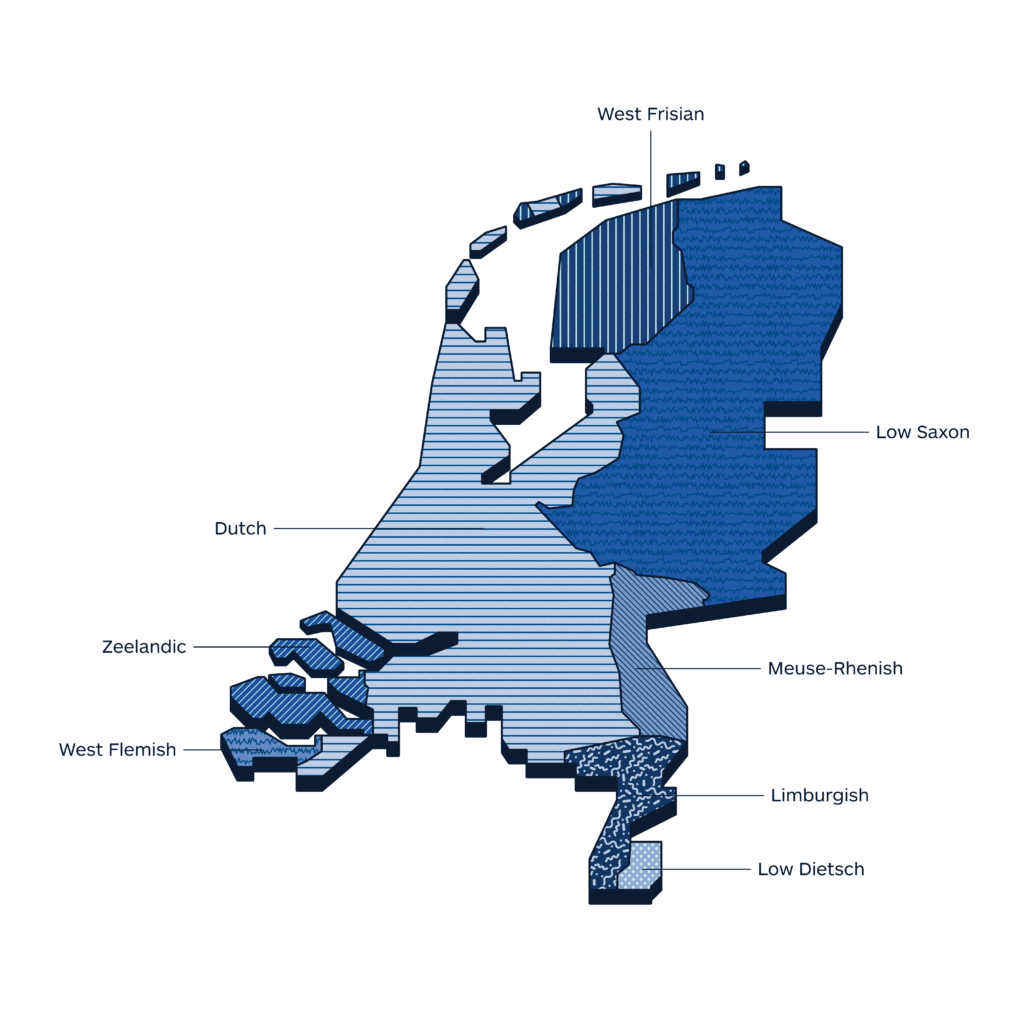Europe
To which language should you translate to localize in the Netherlands?
What we know from our community
“The residents of the tiny sea-hemmed nation pride themselves on speaking multiple languages. Almost every Dutch person speaks English and a little French or German. But if you want to enter the Dutch market and really get in touch with the country, people and its culture; Dutch is the magic word. Because it shows that you want to do your part and actually meet the country and its people. And it’s more than worth it, because Dutch is a beautiful language. Linguistically and historically it can be placed between English and German and apart from the Netherlands it is the official language in Belgium (Flanders), Suriname, Curacao, St. Maarten and Aruba. Dutch is still spoken in some areas of Indonesia, Germany, the United States, Canada and Australia. This makes Dutch the second most spoken Germanic language.
Did you know that Afrikaans, spoken in South Africa, is a daughter language of Dutch and that both languages are mutually intelligible?”
LANGUAGE INSIGHT
Official language
Dutch (95.6%)
Actual languages
Dutch (95.6%), Fries (3.7%), Arabic (0.9%), Turkish (0.8%)
What the top 150 best localized websites in the world do in the Netherlands?
(Top 150 websites listed in the Global by Design ranking – published annually by Byte Level Research, this report provides a list of globally localized websites, showcasing best practices and emerging trends in their globalization)
- 119/150 localize by translating into Dutch
- 1/150 localizes by translating into both Dutch and Dutch Sign Language
- 1/150 localizes by translating into both Dutch and French
- 1/150 localizes by translating into Dutch, French, Spanish, Italian, German, Simplified Chinese, Traditional Chinese, Japanese, Portuguese, Polish, Arabic, Czech, Hungarian and Swedish
- 1/150 localizes by translating into France, Spanish, Italian, German, Simplified Chinese, Japanese, Korean, Portuguese, Russian and Polish
- 1/150 localizes by translating into France, Spanish, Italian, German, Simplified Chinese, Traditional Chinese, Japanese, Korean, Portuguese and Russian
- 1/150 localizes by translating into France, Spanish, Italian and German
- 1/150 localizes by translating into France, Spanish, Italian, German, Simplified Chinese, Traditional Chinese, Japanese, Portuguese, Russian, Romanian, Polish, Arabic, Hungarian, Turkish, Bahasa Indonesia, Thai and Ukrainian
-
3M
-
ABB
-
Accenture
-
Adidas
-
Adobe
-
Airbnb
-
Aldi
-
Amazon
-
American Airlines
-
American Express
-
Apple
-
Audi
-
Autodesk
-
Avis
-
Bayer
-
BMW
-
Booking.com
-
Bosch
-
British Airways
-
Bumble
-
Burberry
-
BYD
-
Canon
-
Capgemini
-
Cartier
-
Caterpillar
-
Chevrolet
-
Cisco Systems
-
Citibank
-
Coca-Cola
-
Costco
-
Dell
-
Deloitte
-
Delta
-
DHL
-
Disney+
-
Dyson
-
eBay
-
Eli Lilly
-
Emirates
-
Ernst & Young
-
Facebook
-
FedEx
-
Ford
-
Four Seasons
-
Fujifilm
-
GE
-
Gillette
-
GoDaddy
-
Google
-
Gucci
-
Haier
-
Heineken
-
Hermès
-
Hertz
-
Hilton
-
Hisense
-
Hitachi
-
Honda
-
Hotels.com
-
HP
-
HP Enterprise
-
HSBC
-
Huawei
-
Hyatt
-
Hyundai
-
IBM
-
IKEA
-
Intel
-
InterContinental Hotels
-
J&J
-
Jack Daniel's
-
Jehovah’s Witnesses
-
John Deere
-
Kellogg's
-
Kia
-
KPMG
-
L'Oréal
-
Land Rover
-
LEGO
-
Lenovo
-
Lexus
-
LG
-
Louis Vuitton
-
Lululemon
-
LUSH
-
Marriott
-
MasterCard
-
McDonald's
-
Mercedes-Benz
-
Merck
-
Microsoft
-
Mitsubishi Electric
-
Nestlé
-
Netflix
-
Nike
-
Nikon
-
Nintendo
-
Nio
-
Nissan
-
NIVEA
-
Oracle
-
Pampers
-
Panasonic
-
PayPal
-
Pepsi
-
Pfizer
-
Philips
-
Pitney Bowes
-
Porsche
-
Procter & Gamble
-
PWC
-
Revolut
-
Rolex
-
Royal Caribbean
-
Salesforce
-
Samsung
-
Sanofi
-
SAP
-
Sephora
-
Shopify
-
Siemens
-
Sony
-
Spotify
-
Starbucks
-
Steelcase
-
Stripe
-
Subaru
-
Tesla
-
The Church of Jesus Christ of Latter-day Saints
-
Tiffany
-
Tinder
-
Toshiba
-
Toyota
-
TripAdvisor
-
Uber
-
United Airlines
-
UPS
-
Visa
-
Volkswagen
-
Volvo Cars
-
Vrbo
-
Walmart
-
Western Union
-
Wikipedia
-
Wise
-
WordPress
-
Workday
-
Xerox
-
Xiaomi (Mi)
-
Zara
-
Zoom
If you need others information, below you can find a selection of economic/social/cultural data
Introduction
Language
Official language
Dutch (95.6%)
Actual Languages
Fries (3.7%), Arabic (0.9%), Turkish (0.8%)
T-index
0.84%
T-Index ranks countries according to their potential for online sales.
English
Very high proficiency (EF) – 1 of 112 countries/regions in the world- 1/34 position in Europe.
Demography
Capital: Amsterdam
Currency: Euro
Population: 17,53 million
Population density: 518 /km2
Economy
GDP: 1.02 trillion USD (2021)
GDP per capita: 58,061.0 USD (2020)
Exports: $511 billion (2020)
Statistics
Internet users: 96% penetration, 16.50 million
Unemployment rate: 4.02% (2021)
Urbanisation: 77.38% (2019)
Literacy: 99% (2019)
Conventions
Numbering system
Arabic numerals and comma as decimal separator and space as thousands separator
Date format: dd-mm-yyyy
Time: 24h time system
Country code: 0031/ 00599
Language data sources: Worldatlas/Britannica//EF/Wikipedia; Demography data sources: IMF/Worldometers; Conventions data source: Wikipedia; Economy data sources: WTO/OEC/CIA/Esomar/Datareportal; Statistics data sources: Datareportal/WorldBank/UN/UNESCO/CEIC/IMF/Culturalatlas/Commisceoglobal
Facts and data
Economy
Imports
$524 billion (2020). Crude Petroleum ($32.1B), Refined Petroleum ($23.8B), Broadcasting Equipment ($21.9B), Computers ($14.7B), and Packaged Medicaments ($13.5B), importing mostly from Germany ($84.8B), China ($64.9B), United States ($42.7B), Belgium ($37.1B), and United Kingdom ($25.1B).
Financial inclusion factors (over 15 years of age)
• 100% have an account with a financial institution
• 39% have a credit card
• 85% make online purchases
Ease of doing business
It is very easy to conduct business (rated 76.1 out of 100) ranked 27th out of 34 OECD high income countries ranked 42nd out of 190 countries worldwide (2019, World Bank)
Exports
$511 billion (2020). Refined Petroleum ($29.7B), Broadcasting Equipment ($19.3B), Packaged Medicaments ($18.8B), Computers ($13.7B), and Photo Lab Equipment ($11.7B), exporting mostly to Germany ($105B), Belgium ($56.1B), France ($43.7B), United Kingdom ($40.3B), and United States ($23.9B)
Main local online stores
bol.com, Coolblue, Albert Heijn, Zalando, wehkamp, Amazon, Jumbo, MediaMarkt, H&M
Economic freedom
‘Mostly free’ (79.5 out of 100) ranked 5th out of 45 European countries ranked 8th out of 186 countries worldwide (2019, Heritage Foundation and Wall Street Journal)
Global Innovation Index
Ranked 4th out of 39 European countries, 6th out of 132 worldwide.
The Global Innovation Index captures the innovation
ecosystem performance of 132 economies and tracks the most recent global innovation trends.
Economy data sources: WTO/OEC/CIA/Esomar/Datareportal
Service import (2018)
Source: OEC
Service export (2018)
Source: OEC
Most complex products by PCI
Product Complexity Index measures the knowledge intensity of a product by considering the knowledge intensity of its exporters
Source: OEC
Most specialised products by RCA Index
Specialisation is measured using Revealed Comparative Advantage, an index that takes the ratio between the Netherlands observed and expected exports in each product
Source: OEC
Export Opportunities by Relatedness
Relatedness measures the distance between a country's current exports and each product, the barchart show only products that the Netherlands is not specialized in
Source: OEC

T-index
Reach most of the online purchasing power
T-Index ranks countries according to their potential for online sales. It estimates the market share of each country in relation to global e-commerce.
Try it nowMedia
Media language
Dutch, English
Information channels
The Dutch approach to public broadcasting is unique. Programmes are made by groups which reflect political or religious currents, or other interests. These organisations are allocated airtime on TV and radio, in line with the number of members they have. Public radio and TV face stiff competition from commercial stations. Viewers have access to a wide range of domestic and foreign channels, thanks mainly to one of the highest cable take-up rates in Europe. Every province has at least one local public TV channel. The three national public TV stations enjoy high audience shares. Freedom of the press is guaranteed by the constitution, as is free speech. Newspaper ownership is highly concentrated.
The press
Algemeen Dagblad – national, daily
NRC Handelsblad – national, daily
De Telegraaf – national, daily
De Volkskrant – national, daily
Trouw – national, daily
Het Parool – Amsterdam daily
Het Financieele Dagblad – financial daily
Elsevier – news weekly
Vrij Nederland – news weekly
Television
NOS – public broadcaster
BVN TV – public, for Dutch-speakers abroad
RTL – commercial, operates RTL4, RTL5, RTL7 and RTL8
SBS – commercial, operates SBS6, Net5 and Veronica
Radio
NOS – public radio, operates news and information station Radio 1, music network Radio 2, pop station 3FM, cultural station Radio
Sky Radio – popular commercial FM station, continuous music
Radio 538 – popular commercial FM station, pop and dance music
BNR Nieuwsradio – commercial, new
News agency
Algemeen Nederlands Persbureau (ANP) – news agency
RNW Media – former international radio, now a public multimedia NGO
DutchNews.nl – news in English
Media data source: BBC
Internet Data
Internet users
96% penetration, 16.50 million
Share of web traffic by device
42.08% mobile phones, 55.02% computers (laptops and desktops), 2.87% tablet devices, others 0.02%
Median speed of mobile Internet connection
94.93 Mbps
Median speed of fixed Internet connection
96.82 Mbps
Mobile connection as a percentage of total population: 120.1%
Percentage of mobile connections that are broadband (3G-5G): 97.7%
Most popular web search engines
Google (95.08%), Bing (2.66%), Duckduckgo (0.72%), Yahoo (0.7%), Ecosia (0.3%), StartPagina (0.22%)
Most used social media
Facebook (65.61%), Pinterest (15.5%), Twitter(9.75%), Instagram (6.32%), YouTube (1.76%), Linkedin (0.37%)
Internet data sources: Datareportal/Statcounter
Social statistics
Life expectancy
81.56 yrs (2020)
Average age of the population
43.3 yrs (2020)
Cultural Curiosities
Communication in both business and social settings tends to be very warm and expressive. Establishing a cordial relationship and gaining the trust of your business counterpart is very important.
Glass Ceiling Index
52.8 out 100, ranked 25nd out of 29 countries.
The glass-ceiling index measures the environment for working women combining data on higher education, labor-force participation, pay, child-care costs, maternity and paternity rights, business-school applications, and representation in senior jobs.
Healthcare expenditure
13% of GDP (2018)
Average age of the population
45.7 yrs (2020)
Literacy
99% (2018)
Urbanisation
91.49% (2018)
Graduates (tertiary education)
Overall, 38% of Dutch adults (25-64 year-olds) have a tertiary education, similar to the OECD average of 39%. However, tertiary educational attainment among younger adults has increased in the Netherlands in the past decade, and the share of 25-34 year-olds with tertiary education increased by 8 percentage points between 2008 and 2018 to 48%, above the OECD average of 44% (2019)
Social statistics sources: WorldBank/UN/UNESCO/CEIC/IMF
The Data Factbook is a work in progress project. Our community is helping us to fill it up always with new and updated data. Your contribution is precious. If you want to help us, please write your advices at imminent@translated.com
Languages research
Languages in the Netherlands

Legend
-
Dutch
-
Low Saxon
-
West Frisian
-
Zeelandic
-
Meuse-Rhenish
-
Limburgish
-
Low Dietsch
-
West Flemish
The geographical distribution of languages that you will find in the maps published in this section is a work in progress. Our community is helping us to fill it up with always new and updated data. Your contribution is precious. If you want to help us, please write to imminent.factbook@translated.com
Photo credit: Marc Kleens, Unsplash


